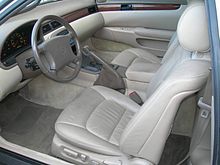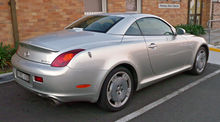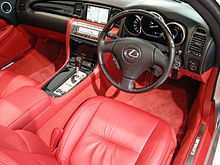Lexus SC
 |
|
| Manufacturer | Toyota Motor Corporation Kanto Auto Works |
|---|---|
| Production | 1991–2010 |
| Assembly | Motomachi, Japan Susono, Shizuoka, Japan Higashi Fuji, Japan |
| Class | Personal luxury coupé cabriolet |
| Layout | FR layout |
In Japan, the related third-generation Toyota Soarer, with which the first generation SC originally shared body design and multiple components, featured a separate line-up of vehicle configurations and different powertrains. The fourth generation Soarer sport coupe, largely identical to the SC 430, was superseded by its Lexus counterpart in Japan when the Lexus marque débuted there in 2005. The SC was the sole coupé in the Lexus lineup until the arrival of the IS C.According to Lexus, the SC designation stands for Sport Coupe.
First generation (Z30)
| Also called | Toyota Soarer (Z30) |
|---|---|
| Production | 1991–2000 |
| Body style | 2-door coupé |
| Engine | 3.0 L 2JZ-GE I6 4.0 L 1UZ-FE V8 |
| Transmission | 4-speed automatic 5-speed automatic (1998-00 SC 400) 5-speed manual (1992-97 SC 300) |
| Wheelbase | 105.9 in (2,690 mm) |
| Length | 191.3 in (4,859 mm) (1992-97) 192.5 in (4,890 mm) (1998-00) |
| Width | 70.5 in (1,791 mm) (1992-97) 70.9 in (1,801 mm) (1998-00) |
| Height | 52.4 in (1,331 mm) (1992-94 SC 300) 52.6 in (1,336 mm) (1995-97 SC 300 & 1992-97 SC 400) 53.2 in (1,351 mm) (1998-00 SC 300/400) |
| Curb weight | 3,506 lb (1,590 kg) (1992 SC 300 manual) 3,505 lb (1,590 kg) (1992 SC 300 automatic) 3,604 lb (1,635 kg) (1992 SC 400) |
1991–2000
In the early 1990s, following the début of Lexus, automotive press reports indicated a forthcoming mid-size Lexus coupé to compete with the luxury coupés of other marques like Mercedes-Benz SL, Acura Legend coupe and Infiniti M30 coupe. At that point, Toyota had no genuine luxury coupés in its model range. A coupe would complement the successful Lexus flagship model, the V8-powered, rear-wheel drive LS 400 sedan.The coupé was going to be targeted towards the American market, and the development effort for its exterior design was handed over to the Calty Design Research center in California.The American Calty design team took a different approach to designing the car, using plaster molding shapes to design the body, and working three-dimensionally instead of the traditional 2-D sketch approach. As described by design chiefs Denis Campbell and Erwin Lui, the result was a car that was based on "emotion and feeling" rather than linear aesthetics. The resulting design possessed almost no straight edges, and produced a drag coefficient of Cd 0.31. According to automotive journalist Bill Russ, the SC design was considered influential among automotive designs of the time.
The SC 400 débuted on June 1, 1991 in the United States as a 1992 model. The SC 400's 4.0 L V8 1UZ-FE, the same engine as used in the LS 400, was reported to have cost over US$400,000,000 in research and development. The SC 400 was honored as the Motor Trend Import Car of the Year for 1992. It also made Car and Driver magazine's Ten Best list for 1992 through 1998.
In July 1992, the SC 300, a smaller engined version of the SC 400, premiered in the United States. The SC 300 was equipped with a 3.0 L inline 6 2JZ-GE. Lexus' traction control system, TRAC, was offered as an option.
The first generation SC lasted in production until July 7, 2000, over nine years, quite long compared to the other cars of the 1990s. Even with the SC's long production cycle, only minor exterior changes were made. New tail lighting and a modified spoiler design was part of the mid-cycle vehicle refresh. A front grille was added in 1997, along with a redesigned front bumper, side skirts and rocker panels. The SC 400 produced 250 hp (186 kW)/260 lb·ft (353 N·m) from 1992–1995. The original 1991–1997 engines for the 2JZ-GE-powered SC 300 were rated at 225 hp (168 kW)/210 lb·ft (285 N·m). The output of the SC 300 was five horsepower more than the equivalent engine used in the Toyota Supra.
In 1996, the SC 400's 1UZ-FE engine design was upgraded to 260 hp (194 kW) from 250 hp (186 kW). These engines were coupled with a 4-speed automatic transmission on both the SC 300 and SC 400 models. A 5-speed manual transmission was only offered on the SC 300 from its debut until 1997. In 1997 (1998 model year), both the SC 300 and 400 were upgraded with VVT-i and thus the ratings were raised to 290 hp (216 kW)/300 lb·ft (407 N·m) of torque for the SC 400 and 225 hp (168 kW)/220 lb·ft (298 N·m) of torque for the SC 300. Tests conducted on the new engines showed an acceleration for the SC 400 for years 1992–1995 of 0–60 mph in 6.9 seconds, years 1996–1997 in 6.7 seconds, and years 1998-2000 in 6.3 seconds. For the SC 300 an acceleration 0-60 mph in 6.8 seconds with the 5 speed manual and 7.2 seconds with the 4 speed automatic for all years. This 1997 upgrade included the replacement of the four-speed automatic on the SC 400 to a five-speed unit. Sales of the automatic transmission SC 300 and SC 400 models formed the majority of models purchased.The Lexus SC 400 was never officially sold in the British Isles, but many examples found their way across the Atlantic as personal imports. The first generation SC coupes were assembled at Toyota's Higashifuji Technical Center in Motomatchi, Japan.
Second generation (Z40)
 |
|
| Manufacturer | Kanto Auto Works (Higashi Fuji plant) |
|---|---|
| Also called | Toyota Soarer (replaced in 2005 with Lexus SC 430) |
| Production | 2001–2010 |
| Body style | 2-door coupé convertible |
| Engine | 4.3 L 3UZ-FE V8 |
| Transmission | 5-speed automatic (2002-05) 6-speed automatic (2006-10) |
| Wheelbase | 103.1 in (2,619 mm) |
| Length | 177.8 in (4,516 mm) (2002-05) 178.5 in (4,534 mm) (2006-10) |
| Width | 72.0 in (1,829 mm) |
| Height | 53.1 in (1,349 mm) |
| Curb weight | 3,840 lb (1,742 kg) |
| Related | Toyota Soarer (Z40) |
| Designer | Sotiris Kovos |
2001–2005
At the 1999 Tokyo Motor Show, Lexus displayed its Sport Coupe concept, a V8-powered convertible, signifying its plans for a replacement for the first generation SC 300/400.The production version of its new sports coupe-convertible, the SC 430, debuted at the Paris Motor Show in 2000. The car was scheduled to go on sale in the second quarter of the following year. Power was provided by a 4.3 L 3UZ-FE V8 engine with variable valve timing (VVT-i) mated to a five-speed automatic transmission. This engine was the same model as that found in the UCF30 Lexus LS. The SC 430's V8 could produce 288 hp (214.76 kW) and 430 N·m (317 lb·ft) of torque, allowing the coupe to go from 0-60 mph in 6.2 seconds.In contrast with the previous generation model, the redesigned Lexus SC was intended as a convertible from its inception.The development team was led by chief engineer Yasushi Nakagawa. Lexus designers from Europe and Japan worked together to create a streamlined design. Led by chief designer Sotiris Kovo, designers traveled to the Côte d'Azur to develop the vehicle's exterior shape, and studied the region's architecture, lifestyle, and harbors. The resulting convertible received character lines similar to the region's yachts, in contrast with traditional waveform lines. The vehicle's side profile, the product of extensive wind tunnel testing, was intended to channel air around the passenger compartment at high speed during top-down driving.
The SC 430 chassis featured a double-wishbone setup for both the front and rear wheels. The vehicle platform shared elements with the GS 430 sport sedan, including variable-assist power rack-and-pinion steering. Safety systems ranged from traction control to vehicle stability control.The convertible received a ULEV emissions certification rating.
The SC 430 featured a retractable aluminium hardtop, all-leather interior with brushed-aluminum accents, navigation screen with folding wood panel, and 18 inch aluminium wheels. Chrome Lexus emblems were mounted on the back of the front seat headrests. The coupe has four seat belts and could technically seat four, but rear seat space is limited.The hardtop fully retracts in 25 seconds. Standard luxury features include Burl Walnut or Bird's Eye Maple wood trim, a Mark Levinson premium sound system, DVD-based navigation system, and headlamp washers. For additional trunk space, as an option the SC 430 could be equipped with run-flat tires.
At its launch, the SC 430 was marketed as the "jewel of Lexus", and as the marque's first convertible, was intended as a more ostentatious addition to the Lexus lineup. Reviewers from Car and Driver magazine praised the SC 430 for 2002 as "an unqualified success", calling it "comfortable, fast, smooth, and quiet" with "all of the virtues expected in a patrician roadster."
In 2004, Lexus unveiled the Lexus SC "Pebble Beach Edition", a limited-production model of the SC. The special edition SC was produced in partnership with the Pebble Beach Company, and featured a unique exterior and interior color combination which changed with each model year. For model years 2004, 2005, and 2006, production of the Pebble Beach edition was limited to 400 units. Each Lexus SC Pebble Beach edition coupe exhibited special badging (featuring the "Lone Cypress" logo) on the front fenders, center console, and floor mats. For the 2006 model, a rear spoiler and spider alloy wheels was also included.
In 2004 and 2005, J.D. Power and Associates' Initial Quality Survey awarded the SC 430 as the highest ranked premium luxury vehicle. Kelley Blue Book gave the SC 430 its Best to Hold Value Award in 2002. In June 2004, a custom-designed Carolina Herrera SC 430 was shown at the Madrid Motor Show. The special edition SC 430 CH used a 'Testa di Moro' body color, with matching interior leather and carpeting, along with designer logos on the wheels and door sills. A line of accessories was also developed for the vehicle.
2005–2010
In 2005 for the 2006 model year, the SC 430 was updated, with changes that included redesigned alloy wheels. In late 2005, the SC 430 premiered along with the Lexus marque in Japan; it was manufactured at the Kanji (Kanto Jidosha) assembly site in Japan. The SC 430 was sold in North America, Europe, Oceania, and Asia; unlike its predecessor, the SC 430 was officially imported to the British Isles; the old SC 400 had been a popular personal grey import.In 2010, a final special edition model for Japan, the SC 430 Eternal Jewel edition, was produced, limited to 200 units. The 2010 model was the last automobile from any major manufacturer in the United States to ship with a cassette tape deck.
Production of the second generation SC ended in July 2010 after nine years of production, but Lexus is still using them in the Super GT until the 2011 season ends.
Third generation
According to Car and Driver, Lexus is working on a "clean sheet" replacement for the SC and the convertible theme will be retained, with a soft top instead of the hard top setup currently being used.In July 2008, Edmunds InsideLine had reported that Lexus had cancelled the next generation SC due to slowing sales. A company spokesman did not confirm or deny the rumors, but called the report in the possible replacement with the introduction of the Lexus LFA as "unfounded speculation."Lexus subsequently announced the production of the SC 430 model for 2009, and in 2010.
Motorsport
The new SC 430 based race cars were immediately competitive with former GT500 champion Juichi Wakisaka and no. 2 driver Andre Lotterer driving the Open Interface TOM's SC to victory at the opening round at Suzuka giving the SC 430 its first victory on its debut race. Juichi Wakisaka and Andre Lotterer also won the GT500 class championship during the same year. In 2007, Lexus SC fully replaces Supras in the Toyota side, a Zent Cerumo SC 430 driven by Yuji Tachikawa was victorious in the GT500 opening round race.
In 2008, a Zent Cerumo SC 430 driven by Yuji Tachikawa and Richard Lyons won the Fuji 500 race, round 3 of the Autobacs Super GT at Fuji Speedway. In 2009, five SC 430s were entered in Super GT racing in the GT500 class, including the Petronas TOM's SC 430 driven by Juichi Wakisaka and Andre Lotterer, along with the Eneos SC 430, Kraft SC 430, Dunlop Sard SC 430, and Zent Cerumo SC 430.
In 2009, the Lexus Team Petronas TOM's SC 430 driven by Andre Lotterer and Juichi Wakisaka was the championship winner in the GT500 series, also the SC 430 was victorious in early rounds at the Suzuka Circuit. In 2010, the SC 430 continued in Super GT competition, where the MJ Kraft SC 430 and other Lexus Team Kraft SC 430s won victories at the 2010 Autobacs Super GT at Fuji Speedway.
In recent years, the SC300 has been rapidly gaining popularity as a platform in the grassroots and professional motorsport of drifting. Despite being a bit heavier than the more common platforms such as the Nissan 240sx, Mazda RX7, and the Toyota AE86, it's long wheelbase and deceptively nimble handling, due to its MKIV Toyota Supra heritage, make it a startlingly robust competitor. It shares its mechanics almost universally with the MKIV Toyota Supra, and thus parts are easy to obtain.
Sales and production
Sales and production data for the first and second generations, based on manufacturer's data:| Chassis code | Model no(s). | Calendar year | Total sales, U.S. | Total sales, Japan | Production figures | ||
|---|---|---|---|---|---|---|---|
| SC 430 AT | |||||||
| UZZ40 | |||||||
| SC 430 | 2001 | 14,333 | not sold | n/a | |||
| 2002 | 14,462 | not sold | 25,427 | ||||
| 2003 | 10,298 | not sold | 10,755 | ||||
| 2004 | 9,708 | not sold | 9,848 | ||||
| 2005 | 8,360 | 539 | 8,941 | ||||
| 2006 | 5,847 | 1,532 | 8,051 | ||||
| 2007 | 3,927 | 872 | 5,673 | ||||
| 2008 | 1,986 | 621 | 2,756 | ||||
| 2009 | 720 | 256 | 333 | ||||
Technical specifications
| Drivetrain specifications by generation | ||||||||
|---|---|---|---|---|---|---|---|---|
| Model year(s) | Model no. | Chassis code(s) | Engine type | Engine code | Transmission(s) | Power | Torque | |
| 1991–1995 | SC 400 | UZZ31 | 4.0 L V8 | 1UZ-FE | 4-speed AT | 250 hp (190 kW) | 260 ft·lbf (350 N·m) @4400 rpm | |
| 1996–1997 | SC 400 | UZZ31 | 4.0 L V8 | 1UZ-FE | 4-speed AT | 260 hp (190 kW) | 270 ft·lbf (370 N·m) @4800 rpm | |
| 1998–2001 | SC 400 | UZZ31 | 4.0 L V8 | 1UZ-FE | 5-speed AT | 290 hp (220 kW) | 300 ft·lbf (410 N·m) @4000 rpm | |
| 1992–1997 | SC 300 | JZZ31 | 3.0 L I6 | 2JZ-GE | 4-AT/5-MT | 225 hp (168 kW) | 210 ft·lbf (280 N·m) @4800 rpm | |
| 1998–2001 | SC 300 | JZZ31 | 3.0 L I6 | 2JZ-GE | 4-speed AT | 225 hp (168 kW) | 220 ft·lbf (300 N·m) @4000 rpm | |
| 2002–2005 | SC 430 | UZZ40 | 4.3 L V8 | 1UZ-FE | 5-speed AT | 300 hp (220 kW) | 325 ft·lbf (441 N·m) @3400 rpm | |
| 2006–2010 | SC 430 | UZZ40 | 4.3 L V8 | 3UZ-FE | 6-speed AT | 288 hp (215 kW) | 317 ft·lbf (430 N·m) @3400 rpm | |












![Validate my RSS feed [Valid RSS]](valid-rss-rogers.png)















































































ไม่มีความคิดเห็น:
แสดงความคิดเห็น